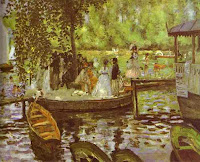 |
| La Grenouillere, 1869, Pierre-Auguste Renoir |
 |
| La Grenouillere, 1869, Claude Monet |
Although I've never done so personally, it's not uncommon for two friends, both artists, to find they so enjoy the inspiration and influence of one anothers company that they take to working together. Sometimes this happens in a studio as with Picasso and Braque, but more often it occurs outside, in painting on location. Women, perhaps being more social than men, do it a lot, as do husbands and wives. Edward Hopper and his wife come to mind for example. It allows the artists to talk about their work, art, feelings, difficulties, or just mundane things like The Days of Our Lives. Painting can be a lonely profession. In so doing, the artists learn from each other, sometimes even begin to paint like each other. In many cases, only art experts can distinguish between a Cubist Braque and a Picasso from the same period. The same is true of the work of two earlier painters--Pierre-Auguste Renoir and Claude Monet. During the summers of 1873 and 1874, they were very nearly "joined at the hip."
 |
| Mme. Charpentier and Her Daughters, 1879, Pierre-Auguste Renoir |
Without their signatures at the bottoms, the work of Monet and Renoir would appear easily to have come from the same hand. Their scenes from La Grenouilliere and Argenteuil on the banks of the Seine are often very nearly identical, one only slightly to the left or the right of the other. There were a few very subtle differences. Renoir's palette tended to have a little more range, sometimes called his "rainbow" palette, than did Monet's. Also, Monet tended toward pure landscapes with only incidental figures while Renoir always placed more emphasis on the figures. Still, during these impoverished, early stages of Impressionism their friendship made them and their work practically inseparable.
 |
| Luncheon of the Boating Party, 1881, Pierre-Auguste Renoir |
It was Renoir's love of the female figure that made the difference between them. It brought him the earliest success of any of the Impressionists, starting with his Mme. Charpentier and Her Daughters in the 1879 Salon. Unlike Monet who labored on in obscurity and poverty for several more years, Renoir took the money and ran. With his new found prosperity, he was able to indulge his love of travel. Not surprisingly, he took off to Italy, soaked up all the Renaissance art he could handle, then came home, complaining that except for a particular Tiepolo he dearly loved, he could see just as good art in the Louvre. He returned to his Montmartre garden studio, married one of the sweet, plump faces in his Luncheon of the Boating Party, and continued to do well, though he was one of the first to forsake Impressionism in favor figural subjects. There were still Impressionistic elements in his backgrounds and colors, but more and more his edges grew harder, his drawing more dominant, and his arthritis more troublesome. For the last twenty years of his life he was largely unable to walk and could only hold a brush with great difficulty. However, his son, the film maker Jean Renoir, debunks the myth that his father had to have the brushes literally tied to his fingers to work. He does concede, however, that his father's fingers were so sensitive that the brush handles irritated them to the point he could only work with linen covering them. Monet, also battled this handicap as well as failing eyesight in his declining years. Though they never again shared the summer sun, as they grew older, they continued to share much in common.
 |
| Water Lily Pond, 1915-26, Claude Monet, painted in two sections totaling some 6 by 18 feet (due to poor eyesight), completed shortly before his death |
Tidak ada komentar:
Posting Komentar